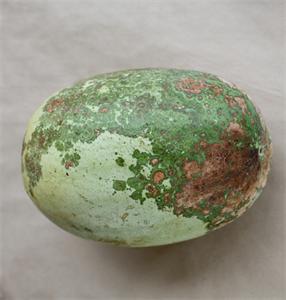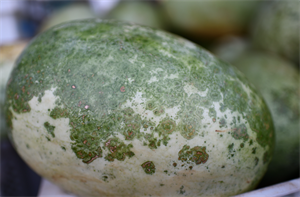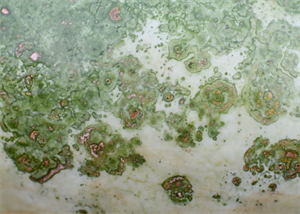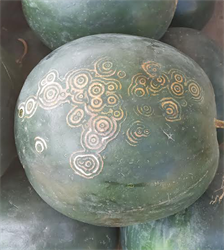Papaya ringspot (virus-W)
Pacific Pests, Pathogens and Weeds - Online edition
Pacific Pests, Pathogens & Weeds
Watermelon - Papaya ringspot (virus-W) (392)
Papaya ringspot virus-W. Previously, it was known as Watermelon mosaic virus-1. However, tests using antisera showed that it was a strain of Papaya ringspot virus. The other strain is Papaya ringspot virus-P, which infects papaya and cucurbits (see Fact Sheet no. 194). Papaya ringspot virus-W does not infect papaya.
Note, a third virus, Watermelon mosaic virus, also infects watermelon and other cucurbits; this virus causes light and dark mottling on the leaves and a slight roughening of the skin of the fruit. It was previously known as Watermelon mosaic virus-2.
Asia, North, South and Central America, the Caribbean, Europe, Oceania. It is recorded from Australia, Cook Islands, Federated States of Micronesia, Fiji, French Polynesia, Guam, Kiribati, Nauru, New Caledonia, Northern Mariana Islands, Palau, Papua New Guinea, Marshall Islands, Samoa, Solomon Islands, Tokelau, Tonga, and Vanuatu.
Chayote (Sechium edule), cucumber, melon, pumpkin, squash, and watermelon. Weeds in the cucurbit family are also hosts, for example, wild bitter melon (Momordica charantia), and ivy gourd (Coccinia grandis).
The virus causes distortions, blisters and light and dark mosaic patterns on leaves. Characteristic ring spots develop on the fruit (Photos 1&2), merging into large dark green areas, more conspicuous on light coloured varieties than those with dark skin (Photos 3&4).
Spread of the disease occurs in two ways. First, aphids spread the virus from infected crops and wild cucurbits to healthy watermelons' and secondly, infected nursery plants spread the virus over short and long distances.
There are many species of aphids that spread Papaya ringspot virus-W naturally, although some species are more efficient than others. In Pacific islands, the aphid Aphis gossypii is common and transmits the virus in a non-persistent way; this means that it acquires the virus on its mouth parts after a short feed on an infected plant (30 seconds or less), infects a healthy plant after another short feed, and then loses the ability to infect. Spread is very rapid by aphids.
This is a serious disease of cucurbits, and in Florida it is said to be a limiting factor on production. The virus can severely reduce fruit set in watermelon. It also affects the quality of the fruit produced as growers are unable to market fruit with ringspots.
Look for the light and dark green mosaic patterns and distortions on the leaves, and the characteristic ringspots on the fruits. However, these are not conclusive, and identification needs confirmation using serological or molecular methods. Other viruses, for example, Cucumber mosaic virus, Watermelon mosaic virus and the papaya strain of Papaya ringspot virus-P can produce similar symptoms.
CULTURAL CONTROL
Before planting:
- Check each seedling for mosaic symptoms on the leaves before taking the plants to the field; discard any that show signs of virus disease.
- Avoid growing overlapping crops; aphids easily take the virus from old to young plants - they fly as well as spread on the wind.
- Weed around the nursery, removing any weeds in the cucurbit family, e.g., the wild bitter melon, Momordica charantia.
During growth:
- Remove any weeds in the cucumber family from around cucurbit plantings (as above), as well as any 'volunteer' (self-sown) plants.
- Restrict movement of people within the planting. Aphids can be taken into fields on people's clothing.
- Remove diseased plants as soon as symptoms are seen. Unfortunately, it is difficult to control watermelon virus diseases this way as the spread by aphids is so fast and by the time symptoms are seen spread has occurred to other nearby plants.
- Grow cucurbits under netting or floating covers. This is very expensive and not a method for small-scale producers and subsistence growers. Also, the netting and covers have to be removed to allow for pollination.
- Use plastic mulches (transparent or silver) as they have been shown to repel aphids and delay virus spread.
After harvest:
- Destroy all crop remains as soon as harvests have finished.
RESISTANT VARIETIES
Although some zucchini varieties are tolerant to Papaya ringspot virus, Watermelon mosaic virus, and Zucchini yellow mosaic virus, commercial seed catalogues are yet to announce watermelon with resistance to Papaya ringspot mosaic virus-W.
CHEMICAL CONTROL
Chemical control is not effective against this disease because aphids are able to transmit the virus so quickly. Usually, by the time the insecticide has killed the aphid, the aphid has fed, and the virus has been transmitted. An exception to this is horticultural oils, either vegetable or petroleum based. Sprays of soaps, white oil (vegetable) or commercial horticultural oils (petroleum) may give some protection if applied frequently (see Fact Sheet no. 56). Use the following recipe for home-made preparations:
White oil:
- 3 tablespoons (1/3 cup) cooking oil in 4 litres water.
- ½ teaspoon detergent soap.
- Shake well and use.
Soap:
- Use soap (pure soap, not detergent).
- 5 tablespoons of soap in 4 litres water, OR
- 2 tablespoons of dish washing liquid in 4 litres water.
Use commercial horticultural oils as indicated on the label. White oil, soap and horticultural oil sprays work by blocking the breathing holes of insects causing suffocation and death. They also stop some insects from feeding, without killing them.
____________________
When using a pesticide (or biopesticide), always wear protective clothing and follow the instructions on the product label, such as dosage, timing of application, and pre-harvest interval. Recommendations will vary with the crop and system of cultivation. Expert advice on the most appropriate pesticide to use should always be sought from local agricultural authorities.
AUTHOR Grahame Jackson & Mani Mua
Information from Davis RI, Ruabete TK (2010) Records of plant pathogenic viruses and virus-like agents from 22 Pacific island countries and territories: a review and an update. Australasian Plant Pathology 39, 265-291; and Papaya ringspot virus. Wikipedia. (https://en.wikipedia.org/wiki/Papaya_ringspot_virus); and from Diseases of vegetable crops in Australia (2010). Editors, Denis Persley, et al. CSIRO Publishing. Photo 4 former Deputy Director and Head of Agricultural Research and Information Division, MAFFF, Tonga.
Produced with support from the Australian Centre for International Agricultural Research under project HORT/2016/18: Responding to emerging pest and disease threats to horticulture in the Pacific islands, implemented by the University of Queensland and the Pacific Community.







